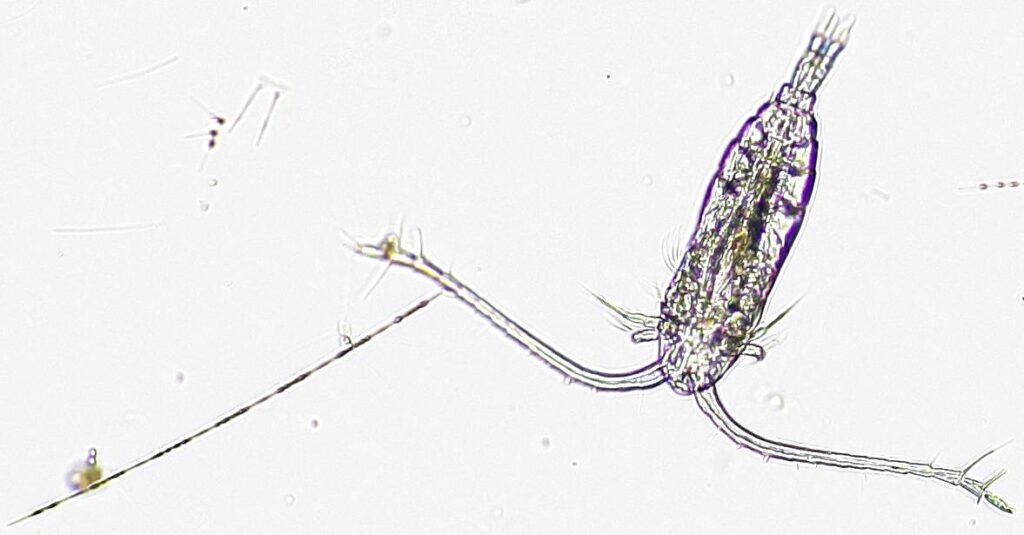
Source: ecotaxa.obs-vlfr.fr/prj/11093
In December, we began a series of workshops to equip citizen scientists with the PlanktoScope – and with it, an efficient way to monitor the ocean’s microscopic inhabitants across exceptional ecological scales.
There’s still so much we don’t know about plankton – the microscopic organisms upon which almost all marine life depends. Billions drift across our oceans, collectively producing roughly half of the Earth’s oxygen and form the basis of our marine food webs.
Considering their importance within the wider ecosystem, these unsung heroes are of big interest to the BIOcean5D team. With our partners – including EMBL, Tara Oceans Foundation and EMBRC – we’re collecting a unique set of samples from across Europe’s coasts to understand how plankton and their wider communities change across the five dimensions of 3D space, time and human impact.
This powerful approach, with cutting-edge techniques and technologies, produces a detailed snapshot of marine biodiversity across levels of biological organisation, from genomes and expressed genes, to proteins and metabolites, and organisms and holobionts.

But capturing the dimension of time could be a challenge if we relied solely on a high-tech research expedition, which takes detailed measurements at one site before moving onto the next. We’re overcoming this hurdle in various ways, including collecting sediment cores that let us look back in time and returning to key sites to collect samples across the seasons.
“Another option is to work with citizen scientists, to gather samples in a more efficient way,” says Fabien Lombard, BIOcean5D team member and associate professor at Sorbonne University, France. “Through BIOcean5D, and together with the long-run initiative Plankton Planet, we’re recruiting citizen scientists – or ‘sea-tizens’ – and providing them with the PlanktoScope.”
This small, affordable, in-flow microscope gives people a tool to collect marine samples and capture good quality quantitative images of the invisible life within – scaling up our ability to document and monitor the invisible world around us.
Frugal science
Pioneered by Plankton Planet, the PlanktoScope is made of simple modules, including a compact digital microscope and a computing module that connects to a web interface. Users can analyse samples, capturing quality images of thousands of micro-plankton at single-organism resolution.

“Because of its frugal design, PlanktoScope can fit within a relatively small budget. For every individual lab we might fit with high-tech equipment, we can equip around 25 labs with a PlanktoScope for the same cost,” describes Fabien, an expert in plankton monitoring and a member of the Plankton Planet team.
Images captured with the PlanktoScope add to a growing digital collection which can help identify, measure and monitor the breadth of plankton diversity at different locations. This resource is incredibly helpful for BIOcean5D, helping us to understand how this crucial part of the marine ecosystem changes over space and time and with the impact of human activity.
A community of sea-tizens
In December, Fabien and the team ran our first workshop, in collaboration with Plankton Planet, deploying the first 10 PlanktoScopes to a group of scientists and students in Villefranche, France. As well as controlling the device, participants learned how to apply taxonomy to images and run machine learning tools to extend identification to full and complex datasets.
“By providing training, we’re starting to build an interconnected network of PlanktoScope users, who share common methodologies and future datasets,” describes Fabien. “The workshop in December was a real success.”

Newly trained participants will now be able to use the devices as part of their existing marine projects, including NGO- or citizen-led environmental monitoring programmes, and join a growing network of PlanktoScope users across the globe. Their images will contribute to the BIOcean5D database, which will be made openly available for research – and which we hope will seed the first sea-tizen planetary measure of plankton biodiversity, Plankton Planet’s overarching goal.
“For every scientist on a research vessel at sea, there are thousands of citizens working in our oceans and living on our shores who could also be interested in collecting samples and measuring plankton,” describes Fabien. “Citizen science lets us unlock a potential explosion of measurements.
“Equipping even a few of these people with frugal yet robust and scientifically sound instruments and teaching them how to use them could let us monitor ocean life in a much more efficient way.”
The next workshops will be held in January, then later in 2024 and early 2025.
*Images collected at Plankton Planet workshop in December 2023: https://ecotaxa.obs-vlfr.fr/prj/11093

